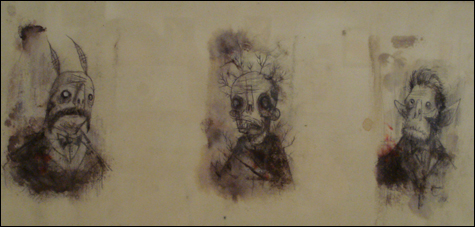
THE UNCASVILLE THREE: Joe Keinberger likes “ne’er do wells who have taken part in some of the
darker events of our history.”
|
Boston art can often seem constipated. This is an academic, institutional city. Although the area’s colleges are renowned for their innovative thinking, in the visual arts the local institutional mindset often means a focus on decorum, a certain polish, and fitting in. That’s not to say it doesn’t produce any good stuff, just that the scene favors playing it safe.
Somerville, though, has become a bastion for the wild and woolly. One sign is the city’s public festivals: the Meet Under McGrath open-air dance party this past August, held under the godforsaken overpass where the McGrath Highway bridges Washington Street; the Fluff Festival, a tribute to the corporate confection in Union Square this past September; the Honk Fest, a gathering of and performance by radical marching bands from across North America in Davis Square this past October. And at this past weekend’s Artbeat in Davis Square, the theme of the annual art and craft fair was beasties.
Another sign is the Somerville “art gangs” — the Lady Cougars, the Miracle 5, and the Olde Ghosts — rounded up in the group exhibition “Leave the Light On” at Somerville’s Nave Gallery. They have in common a punky illustrative goth bent, and a rascally sense of humor. “I don’t think any of us take ourselves too seriously,” says the Lady Cougars’ Beth Driscoll, who organized the show. It’s an uneven exhibit, but it’s energized by their attitude.
These groups are not collaborators who subsume their visions to collectively author works the way Boston’s Institute for Infinitely Small Things or Providence’s Paper Rad do. The Somerville collectives are artists in their late 20s and 30s with similar turn-ons. They show together and give each other advice and encouragement, but generally work solo.
The Lady Cougars formed about six years back. They had met each other at shows around town and found they shared interests in gender issues and female sexuality. And they craved artistic camaraderie and conversation about their work. The name came when they were joking once about getting vests with a gang name on the back. Rebecca Hesketh suggested Lady Cougars. “We were just trying to come up with something ridiculous,” Driscoll says. It’s encouraged them to have a roller derby crew vibe.
These days membership includes Hesketh, Driscoll, Alethea Roy, Briana Horrigan, Maria Davis, and Carly Weaver (who has moved to Texas). Here they contribute portraits of each other, grouped by subject.
In the group of portraits of Davis, Driscoll presents a color photo of the dyed redhead, her upper arms dense with tattoos, sitting on a bed in white tulle dress with bloody banged knees. Hesketh draws Davis in a cabaret dancer’s outfit with floating roses below a banner reading “peach.” Horrigan’s Bear Hug, inspired by Davis, depicts a bear embracing a woman as they stand shoulder-deep in a misty pond. It’s the finest piece in the show. The bear’s hug, rendered in delicate pencil lines and paint washes, is weirdly tender and sexy. The bear’s long claws draped across the woman’s shoulder suggest restrained violence. The woman’s closed eyes hint that maybe this is her dream.
Davis stitches together modest patchwork portraits of the other Lady Cougars on pillowcases from scraps of felt and satin that she uses to make costumes for her burlesque dancing. Roy tries to channel the mythical, fairy-tale monster archetypes of her comrades in clunky paintings — Hesketh becomes a gorgon, Driscoll develops a unicorn horn and floppy ears, Horrigan is a “meremaiden” chomping on a fish.
Driscoll based her photos of the Lady Cougars on self-portraits they made, trying to meld their self-representation with her own vision. In a black-and-white shot, Hesketh appears in a fur hat and bikini with what appears to be a toy bird perched on her arm. And there’s a disconcerting dark wet spot that appears like a wound along her belly. Roy is a bleached-blonde woman in a black dress submerged in a blue inflatable pool with a black spider doll crawling along the edge. In the past, Driscoll’s best photos were energized by nostalgic lyricism and crisp fresh details. Here she’s devised an interesting method, but doesn’t seem to have found her voice within it yet, and so the images feel a bit generic.
The Miracle 5, a wacky superhero-themed collective which formed a couple years back, is represented by two of its five members, Elaine Bay and Raul Gonzalez. (I should note here that I’ve been friendly with some of the Miracle 5 folks for years and exhibited with four of them at the Nave last fall.)